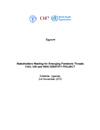Stakeholders Meeting for Emerging Pandemic Threats FAO, OIE and WHO IDENTIFY PROJECT, Entebbe, Uganda, 2-4 November 2010
Executive summary
Emerging diseases continue to cause challenges for the public health and veterinary communities. Through the Emerging Pandemic Threats (EPT) Program, USAID funds FAO, OIE and WHO for their collective involvement in the IDENTIFY Project. This project is intended to strengthen laboratory diagnostic capacities through the development of laboratory networks spanning animal and human health sectors in initially 9 countries1 in the Congo Basin region. FAO, OIE and WHO organized a meeting from 2 to 4 November 2010 in Entebbe, Uganda, to engage regional stakeholders in laboratory capacity building and networking activities. About a hundred participants actively took part in this meeting from both human and animal health sectors. The general objective of the meeting was to obtain country buy-in and ownership for the IDENTIFY project and activities, which was achieved. Presentations on the IDENTIFY Project were followed by six (6) country presentations on their current status of laboratories and priorities for targeted diseases. Further discussions were held through group work which were consolidated during subsequent plenary discussions.
The key achievements of the meeting were:
- The development of preliminary lists of targeted animal and human diseases and conditions (including zoonoses) for the IDENTIFY project. It was proposed that the project implementation team propose harmonized animal and human disease lists.
- The identification of issues affecting laboratory capacityThe discussion of key strategies and activities needed for strengthening the diagnostic capacities of laboratories
- Commitment to improve collaborations between the human and animal health sectors in the region
- The formulation of recommendations directed to the IDENTIFY Project implementation team and beneficiary governments.
The main recommendations from the meeting were to:
- Develop and/or strengthen a sustainable system of networking laboratories
- Support the establishment of a framework for collaboration between animal and human health laboratories
- Strengthen existing collaboration within and between sectors
- Assess and identify gaps in laboratory capacity
- Support normative laboratory function
- Enhance quality assurance, biosecurity and biosafety levels
- Support laboratories on equipment and equipment maintenance
- Provide opportunities for training within and across sectors on cross-cutting themes
- Raise awareness of stakeholders on the importance of laboratories
- Implement or reinforce the laboratory component of Rapid Response Teams
- Strengthen wildlife laboratories



